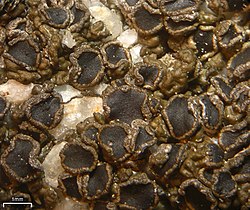| Protoparmelia | |
|---|---|
 | |
| Closeup of Protoparmelia badia; scale bar is 1 mm | |
| Scientific classification | |
| Domain: | Eukaryota |
| Kingdom: | Fungi |
| Division: | Ascomycota |
| Class: | Lecanoromycetes |
| Order: | Lecanorales |
| Family: | Parmeliaceae |
| Genus: | Protoparmelia M.Choisy (1929) |
| Type species | |
| Protoparmelia badia | |
Protoparmelia is a genus of lichenized fungi in the family Parmeliaceae. [1] The genus has a widespread distribution, and contains 11 species. Protoparmelia was circumscribed by French lichenologist Maurice Choisy in 1929. [2]